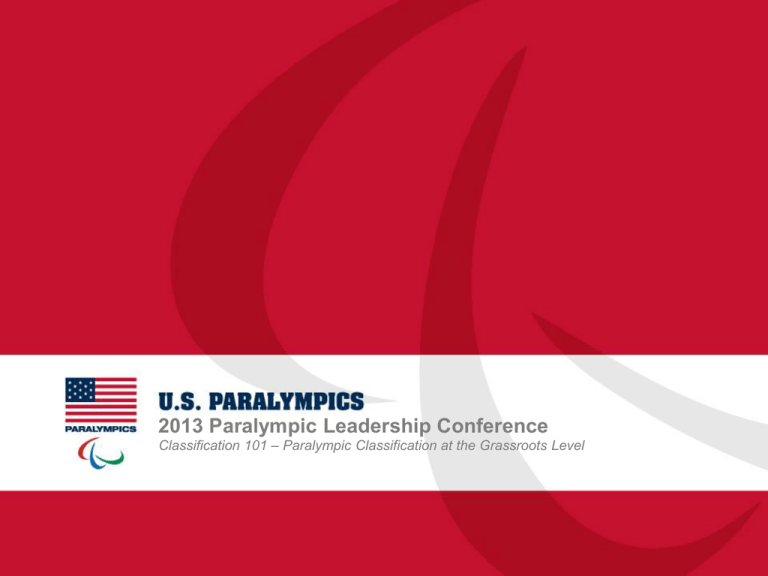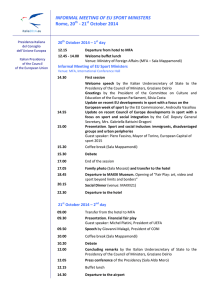Classification 101 Sport Class
advertisement

2013 Paralympic Leadership Conference Classification 101 – Paralympic Classification at the Grassroots Level Classification 101 Classification 101 – Paralympic Classification at the Grassroots Level West Wing Conference Center Presenter: Julie O’Neill, U.S. Olympic Committee/U.S. Paralympics This session will provide a broad overview of the basics of classification, including review of the International Classification Code and the U.S. Paralympics National Classification Policies & Procedures – what they are, what’s new, what has changed, how they affect your program, what the impact is for athletes, and where to go for resources and more detailed information when needed. Ample time will be provided for Q&A to address specific programmatic and/or sport-related questions. Classification 101 What is Classification? Classification is a structure for competition. Paralympic athletes have an impairment in body structures and functions that leads to a competitive disadvantage in sport. Consequently, criteria are put in place to ensure that winning is determined by skill, fitness, power, endurance, tactical ability and mental focus, the same factors that account for success in sport for athletes who are able-bodied. Classification is the process by which athletes are assessed by reference to the impact of impairment on their ability to compete in a specific sport. Classification 101 Paralympic Classification Impairment Groups • Spinal Cord Injury (SCI) – includes Spina Bifida • Cerebral Palsy (CP) – includes TBI (Traumatic Brain Injury / Stroke) • Amputee (Dysmelia) • Les Autres • Blind / Visual Impairment • Intellectual Impairment CLASSIFICATION 101 Paralympic Classification Impairment Groups + SPORTS 6 CLASSIFICATION 101 The “CODE” The International Paralympic Committee (IPC) adopted a universal classification code in an effort to support and coordinate the development and implementation of accurate, reliable, consistent, and credible sport-specific classification systems. The Code was voted upon at the 2007 IPC General Assembly. The Code was signed by National Paralympic Committees (NPCs), International Federations (IFs), and other relevant parties at the 2008 Beijing Paralympic Games. The Code became effective for all signatories as of the Opening Ceremonies of the 2010 Vancouver Paralympic Games (March 12, 2010). The Code outlines policies and procedures that are to be addressed and included within all sports’ classification rules. • • • • • Protests & Appeals Classifier Education Athlete Evaluation Sport Class Status Allocation Master List 7 CLASSIFICATION 101 Policy, Rules & Regulations Each sport International Federation (IF) may have its own classification rules, but those rules must comply with the Code. Each sport IF must maintain a classification master list. It is incumbent upon each National Paralympic Committee (NPC) that is a signatory of the Code to ensure that national classification policies and procedures are in compliance with the Code. • A Protest is the procedure by which a formal objection to an Athlete’s Sport Class is submitted and subsequently resolved. • An Appeal is the procedure by which a formal objection to the manner in which classification procedures have been conducted is submitted and subsequently resolved. 8 CLASSIFICATION 101 U.S. Paralympics National Classification Strategy The three core documents of the U.S. Paralympics Classification strategy are available as PDF downloadable documents at www.usparalympics.org. The USA Classification Policies and Procedures – GENERAL document addresses the aspects of classification that are applicable across all sports including governance; sport class statuses; protests, reviews and appeals; classification panels; and roles and responsibilities. The USA Classification Policies and Procedures – LOC document includes information for local organizing committees that wish to conduct national classification at their competitions including how to request a classification panel, determination of athletes to be classified, facility needs, and roles and responsibilities. The USA Classification Policies and Procedures – Education and Training document covers roles and responsibilities of the classifier, prerequisites for classifier training, levels of classifier certification and competency, and classifier training and education. Classification 101 Sport Class A sport class is a category defined by each International Federation [IF] in which athletes are categorized in reference to activity limitation resulting from impairment for that particular sport. Athletes are allocated a sport class (or sport classes as relevant) based on the classification rules of each IF. Ineligibility to compete is considered a sport class. 26 Paralympic sports – each has own classification system and SPORT CLASSES. Complex systems ATH – 29 sport classes CYC – 12 sport classes SWI – 14 sport classes SKA – 15 sport classes Simple systems – eligible vs. not eligible (PWR, ICE, VBL) Not Eligible is a “sport class”. Classification 101 Sport Class Status International Sport Class Status The Code defines three (3) international sport class statuses for allocation following athlete evaluation. A sport class status is allocated to each athlete to indicate evaluation requirements and protest opportunities. The three international sport class statuses are: N – New R – Review C – Confirmed National Sport Class Status & Sport Class National sport classes will strictly adhere to the athlete evaluation guidelines set out by each respective IF. There will be no variation from the IPC/IF Sport Class evaluation system and the respective Sport Class designations in the national classification process. The three national sport class statuses are: NN – National Classified NR – National Review NC – National Confirmed 11 CLASSIFICATION 101 Resources International Paralympic Committee (IPC) International Classification Code Paralympic Games Classification Guides www.paralympic.org U.S. Paralympics (NPC) National Policy & Procedure documents National SPORT Master Lists www.usparalympics.org Sport-specific rules/regulations/policies IPC and IFs (International) NGBs / NFs (National)





